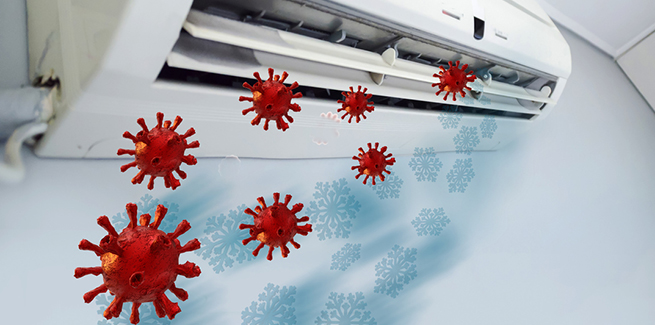Is COVID in your A/C?

We know that COVID is spread through respiratory droplets sprayed into the air when people sneeze, cough, talk, or even sing. But a growing number of scientists say those droplets linger in the air, like dust or a fine mist, for much longer that previously suspected in the form of aerosols, which are droplets smaller than five microns (a micron is equal to one-millionth of a meter).
The process is called aerosolization, and it could explain the alarming spike in COVID cases—often clustered around public place such as bars, restaurants, and casinos—across the US as many states have begun to relax social distancing measures.
The possibility that COVID is aerosolized means virus particles can float in the air and get sucked into ventilation systems, where they can be recirculated through heating, ventilation, and air conditioning (HVAC) systems and theoretically contaminate whole buildings.
Including animal hospitals.
NEWStat spoke with 20/20 Engineering, a Louisville, Colorado, mechanical and plumbing engineering firm that partners with veterinary hospital and animal shelter architectural experts Animal Arts on the design of their ventilation systems to find out more. 20/20 employees Carrie Pepperdine, a mechanical engineer and specialist in HVAC design, and Jerry Oglesbee, an HVAC expert, discussed the aerosolization issue with NEWStat.
First, the good news: they say most animal hospitals have pretty good HVAC systems due to concerns about containing smells and other airborne pathogens that come with the practice of veterinary healthcare. So, whichever way the science winds up pointing, your hospital’s probably in a pretty good position to handle it.
Pepperdine says 20/20 follows the guidance of the American Society of Heating, Refrigeration, and Air Conditioning Engineers (ASHRAE): “They’ve really been on top of [COVID-19 in general, and the aerosolization question in particular], keeping track of the latest science and putting out recommendations [that have] stayed pretty consistent since [the pandemic] started.”
ASHRAE recently published this statement on COVID aerosolization on their website: “Transmission of SARS-CoV-2 through the air is sufficiently likely that airborne exposure to the virus should be controlled. Changes to building operations, including the operation of heating, ventilating, and air-conditioning systems, can reduce airborne exposures.”
Pepperdine says that, according to ASHRAE, “The number-one way to prevent the spread [of COVID] through HVAC systems is to increase the ventilation of air as much as possible, which is quite helpful for veterinary facilities.” She says most hospitals build in strong exhaust-air capabilities to reduce the spread of smells from area to area within the building. For 20/20, building in that kind of muscle is standard practice when designing systems for animal hospitals.
The kind of filters in your system makes a big difference, too.
Minimum Efficiency Reporting Value (MERV) is a system used to evaluate the efficiency of an air filter based on how effective it is at catching particles of varying sizes. “MERV-7 is the standard minimum filtration,” Pepperdine says. “ASHRAE leans more toward going with a MERV-13 filter in conjunction with increasing the ventilation rate.” She says hospitals might want to look into upgrading their filters.
“MERV-13 filters are around 90% efficient at removing contaminants,” says Oglesbee. He compares that to an N-95 mask, which is 95% efficient.
High-efficiency particulate air (HEPA) filters are the gold standard for air filtration: They are 99.97% effective at removing dust, pollen, mold, bacteria, and any airborne pathogens 0.3 microns in diameter.
That’s pretty good, but possibly not good enough: “If [COVID] is airborne, it's most likely coming through at a slightly smaller size,” says Pepperdine. But, like much of the science surrounding COVID, “they don’t know for sure.”
The downside to HEPA filtration? “HEPA filters are way more expensive,” Oglesbee says. Plus, it requires more power to run the fans, so there’s an additional energy cost. Due to the combined costs, 20/20 usually only specifies the use of HEPA filters in surgery suites and operating rooms at specialty hospitals.
Another consideration is how long the virus lives on different surfaces, for which there’s no clear consensus. Oglesbee’s frustration is apparent: “That’s been all over the map [over] the past few months.” He says even if COVID can’t get through the HEPA filtration, “that doesn’t mean [the HEPA filter] isn’t itself a contaminated surface that needs attention.”
That lack of consensus on the science is one reason Oglesbee is reserving judgment on the dangers of aerosolized COVID and HVAC systems: “There might be some aerosol particles that get into the system, but actually getting into the equipment and filters and getting [recirculated] back into the building?” He’s not sure how likely, and says no one is. “The research isn’t far enough along to say one way or another.”
At the same time, he tries to take the long view: “We’re only six months into this, and it’s going to take the industry a little while to come to a consensus as to the best [way to deal with COVID].”
In the meantime, there are low-cost precautions that hospitals can take.
Pepperdine says one such option would be to change out or upgrade air filters. Another is to make sure the outside air dampers are set to optimize their ventilation rate. “Most likely, hospitals already have this capability in place,” she adds, but recommends hiring HVAC professionals to do it.
The good news is, those are precautions. Pepperdine says that if your HVAC system is up to date and regularly maintained, you probably don’t have to worry—what you have in place is probably fine.
But if you’re still worried about aerosolization and you feel the need to do something, Pepperdine has a tip: The easiest thing you can do? Run your exhaust fans and air conditioning. All the time. Even when nobody’s there.
“Even if you're not a 24/7 facility,” Pepperdine says, “make sure you run your exhaust fans and air-conditioning/ventilation units 24/7.”
Higher energy bill aside, it’s probably the easiest thing you can do.
Photo credit: © iStock/summerphotos



